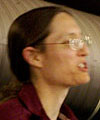 This award was presented to Karen Felzer, USGS Pasadena, at the 2010 annual meeting in Portland, Oregon. In her relatively young career, Felzer has produced transformative and sometimes valuably controversial research by utilizing statistical approaches to tackle tough seismological questions. Her oft-cited work has constructively challenged previously held theories and reshaped the way earthquake physics is understood. While completing her doctoral work at Harvard, Felzer produced three publications that focused on a statistical approach to earthquake clustering and provided a clearer view of how earthquake sequences work. She confirmed earlier work by others that foreshock-mainshock pairs are, statistically, simply cases where an aftershock is larger than the initial event. This led her to conclude that robust and useful calculations can be made of the probability that a given earthquake will be followed by a larger earthquake across a given time and distance using these empirical aftershock statistics. During her post-doc work, Felzer documented that studies of aftershock rates are often confounded by the inclusion of background events, which is a particular problem as one looks for distant aftershocks. Felzer has also been a key contributor to the Working Group on California Earthquake Probabilities. Among other contributions, she created a uniform, long-term seismicity catalog and then used this catalog to estimate expected seismicity rates. The drills developed for the Great Southern California ShakeOut relied on aftershock scenarios that Felzer produced.
This award was presented to Karen Felzer, USGS Pasadena, at the 2010 annual meeting in Portland, Oregon. In her relatively young career, Felzer has produced transformative and sometimes valuably controversial research by utilizing statistical approaches to tackle tough seismological questions. Her oft-cited work has constructively challenged previously held theories and reshaped the way earthquake physics is understood. While completing her doctoral work at Harvard, Felzer produced three publications that focused on a statistical approach to earthquake clustering and provided a clearer view of how earthquake sequences work. She confirmed earlier work by others that foreshock-mainshock pairs are, statistically, simply cases where an aftershock is larger than the initial event. This led her to conclude that robust and useful calculations can be made of the probability that a given earthquake will be followed by a larger earthquake across a given time and distance using these empirical aftershock statistics. During her post-doc work, Felzer documented that studies of aftershock rates are often confounded by the inclusion of background events, which is a particular problem as one looks for distant aftershocks. Felzer has also been a key contributor to the Working Group on California Earthquake Probabilities. Among other contributions, she created a uniform, long-term seismicity catalog and then used this catalog to estimate expected seismicity rates. The drills developed for the Great Southern California ShakeOut relied on aftershock scenarios that Felzer produced.
Karen Felzer
Charles F. Richter Early Career Award | 2009 Recipient
